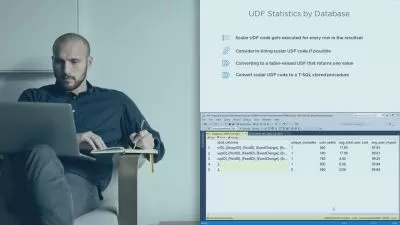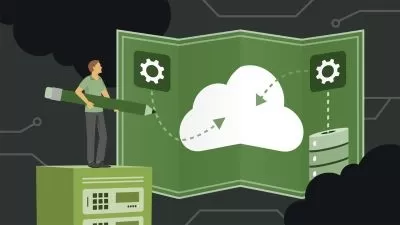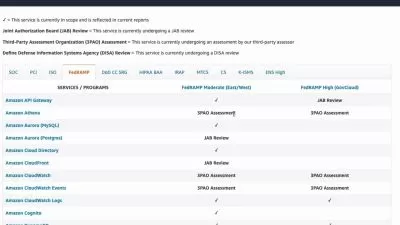Serverless Framework for AWS Stack Deployment(with Dynamodb)
Ajay Gupta
5:09:59
Description
Learn serverless framework basics, setup lambda and understand advance dynamodb concepts
What You'll Learn?
- Serverless Framework
- Deploying AWS stack using serverless template
- Lambda CRU using Dynamodb
- Dynamodb concepts
Who is this for?
What You Need to Know?
More details
DescriptionUse serverless framework to deploy AWS stacks
Deployments
Local Testing methods
Offline
Invoke
Understand Dynamodb concepts in detail:
Primary, Partition, and Sort Keys
Secondary Indexes(LSI-GSI)
Read Consistencies
Capacity modes and Throughput
Streams
Using Different variables in serverless framework:
Nested Variables
Secrets and SSM store Variables
JSON config variables
.env file variables
Advance variable concepts
lambda CRUD with Dynamodb
GET
CREATE/UPDATE
SCAN
QUERY
Event Driven Lambda triggers
Dynamodb Streams
SES
Serverless computing has revolutionized the way applications are built and deployed in the cloud. It enables developers to focus solely on writing code without worrying about server management, scalability, and infrastructure complexities. In this context, the Serverless Framework and DynamoDB play crucial roles in building serverless applications efficiently and effectively.
The Serverless Framework is an open-source tool that simplifies the deployment and management of serverless applications across different cloud platforms. It provides a powerful abstraction layer on top of cloud services, allowing developers to define their application's infrastructure as code. With the Serverless Framework, developers can easily configure and deploy serverless functions, event triggers, and API gateways, making it an ideal choice for building scalable and event-driven architectures.
DynamoDB, on the other hand, is a fully managed NoSQL database service provided by AWS. It offers seamless scalability, high availability, and low latency for applications with any scale of workload. DynamoDB's serverless nature eliminates the need for managing database servers, enabling developers to focus on building their applications' functionality. It provides a flexible schema-less data model, automatic data replication, and built-in support for multi-region global tables.
Combining the Serverless Framework and DynamoDB provides a powerful foundation for developing serverless applications that can handle a wide range of workloads. With the ability to seamlessly scale and manage both the compute and data layers, developers can focus on delivering value to their users while the underlying infrastructure is taken care of.
In this course, we will explore the features, benefits, and best practices of using the Serverless Framework and DynamoDB together. We will dive into the concepts of serverless architecture, learn how to define serverless functions and data models, and discover the integration possibilities between these two powerful tools. By the end, you will have a solid understanding of how to leverage the Serverless Framework and DynamoDB to build highly scalable and efficient serverless applications.
Who this course is for:
- Developers
- Architects
- Managers
Use serverless framework to deploy AWS stacks
Deployments
Local Testing methods
Offline
Invoke
Understand Dynamodb concepts in detail:
Primary, Partition, and Sort Keys
Secondary Indexes(LSI-GSI)
Read Consistencies
Capacity modes and Throughput
Streams
Using Different variables in serverless framework:
Nested Variables
Secrets and SSM store Variables
JSON config variables
.env file variables
Advance variable concepts
lambda CRUD with Dynamodb
GET
CREATE/UPDATE
SCAN
QUERY
Event Driven Lambda triggers
Dynamodb Streams
SES
Serverless computing has revolutionized the way applications are built and deployed in the cloud. It enables developers to focus solely on writing code without worrying about server management, scalability, and infrastructure complexities. In this context, the Serverless Framework and DynamoDB play crucial roles in building serverless applications efficiently and effectively.
The Serverless Framework is an open-source tool that simplifies the deployment and management of serverless applications across different cloud platforms. It provides a powerful abstraction layer on top of cloud services, allowing developers to define their application's infrastructure as code. With the Serverless Framework, developers can easily configure and deploy serverless functions, event triggers, and API gateways, making it an ideal choice for building scalable and event-driven architectures.
DynamoDB, on the other hand, is a fully managed NoSQL database service provided by AWS. It offers seamless scalability, high availability, and low latency for applications with any scale of workload. DynamoDB's serverless nature eliminates the need for managing database servers, enabling developers to focus on building their applications' functionality. It provides a flexible schema-less data model, automatic data replication, and built-in support for multi-region global tables.
Combining the Serverless Framework and DynamoDB provides a powerful foundation for developing serverless applications that can handle a wide range of workloads. With the ability to seamlessly scale and manage both the compute and data layers, developers can focus on delivering value to their users while the underlying infrastructure is taken care of.
In this course, we will explore the features, benefits, and best practices of using the Serverless Framework and DynamoDB together. We will dive into the concepts of serverless architecture, learn how to define serverless functions and data models, and discover the integration possibilities between these two powerful tools. By the end, you will have a solid understanding of how to leverage the Serverless Framework and DynamoDB to build highly scalable and efficient serverless applications.
Who this course is for:
- Developers
- Architects
- Managers
User Reviews
Rating
Ajay Gupta
Instructor's Courses
Udemy
View courses Udemy- language english
- Training sessions 39
- duration 5:09:59
- Release Date 2023/08/16

















